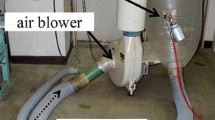Abstract
A few fire retardant intumescent coatings based on ammonium phosphate, cyanoguanidine, 2- 2 bis hydroxymethyl 1,3-propanediol (polyol), and a binder (a copolymer of vinyl acetate acrylate copolymer emulsion and an amino resin) have been developed for wood and wood-based products. The fire performance of the coatings has been evaluated employing differing BS and ASTM standards. On exposure, the coated specimens neither show any surface spread of flame nor any afterglow combustion. The coatings are found to be quite effective in reducing smoke generation, and they possess good water repellency and adhesion.
Similar content being viewed by others
References
Jain, J.P., et. al., “Fire Retardant Treatment for Absorbing Lining Materials,”The Fire Engineer,7 (July–Sept. 1982), pp. 9–15.
Baker, D.S., “Flame Retarding Wood and Timber Products,”Chemistry and Industry,2 (15 Jan. 1977), pp. 74–79.
Baker, D.S., “Wood in Fire, Flame Spread and Flame Retardant Treatments,”Chemistry and Industry,14 (18 July 1981), pp. 485–490.
Jain, J.P., et. al., “Flame Spread in Wood and its Control,”Indian Planner & Builder,2,3 (1982), pp. 9–12.
Dua, A.C., “Fire Retardant Paints: Effect of Various Additives in Their Formulation,”Paint India,32,7 (1982), pp. 3–5.
Mishra, J.P. and Srivasamban, M.A., “Fire Retardant Coatings,”Paint India,29,6 (1979), pp. 21–26.
Lyons, J.W., “The Chemistry and Uses of Fire Retardants,”Wiley Intersciences, New York (1970), pp. 248–272.
Bhatnagar, V.M. and Vergnaud, J.M., “Fire Retardant Paints,”Paint India,33,7 (1983), pp. 15–17.
Jain, J.P., et. al., “Fire Retardant Surface Coating for Cellulosic Materials,”Research and Industry 30 (1985), pp. 20–24.
ASTM D 1360, “Standard Method of Test for Fire Retardancy of Paints,” (Cabinet Method), American Society for Testing and Materials, Philadelphia, PA 19103 (1979).
BS:476, “Fire Tests on Building Materials and Structures,” Part 7,Surface Spread of Flame Tests for Materials, British Standard Institution, London (1971).
BS:476, “Fire Tests on Building Materials and Structures,” Part 6,Method of Test for Fire Propagation for Products, British Standard Institution, London (1981).
ASTM E662, “Standard Test Method of Specific Optical Density of Smoke Generated by Solid Materials,” American Society for Testing and Materials, Philadelphia, PA 19103 (1979).
IS:101, “Methods of Tests for Ready Mixed Paints and Enamels,” Indian Standard Institution, Manak Bhavan 9, Bahadur Shah Zafar Marg, New Delhi 1 (1964).
Clark, F.B. and Lyons, J.W., “The Alcoholysis of Polyphosphoric Acid,”J. Amer. Chem. Soc.,88 (1966), pp. 4401–4405.
Smith, T., “Flame Resistant and Intumescent Paints and Compounds: A Review,”Pigment and Resin Technology 11,4 (1982), pp. 15–18; and13,5 (1984), pp. 9–10.
Author information
Authors and Affiliations
Rights and permissions
About this article
Cite this article
Saxena, N.K., Gupta, D.R. Development and evaluation of fire retardant coatings. Fire Technol 26, 329–341 (1990). https://doi.org/10.1007/BF01293077
Issue Date:
DOI: https://doi.org/10.1007/BF01293077




